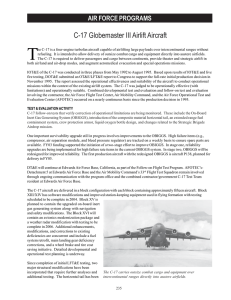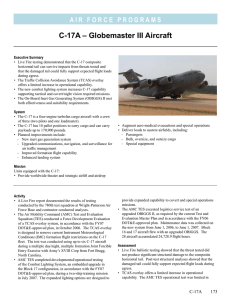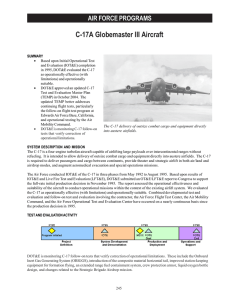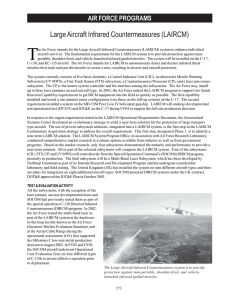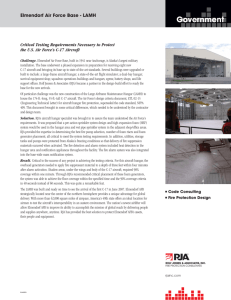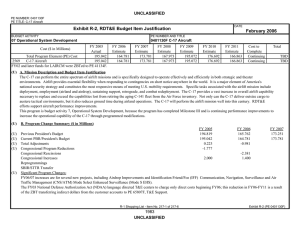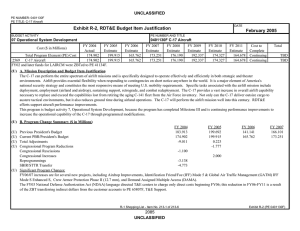CRS Report for Congress Military Airlift: C-17 Aircraft Program
advertisement
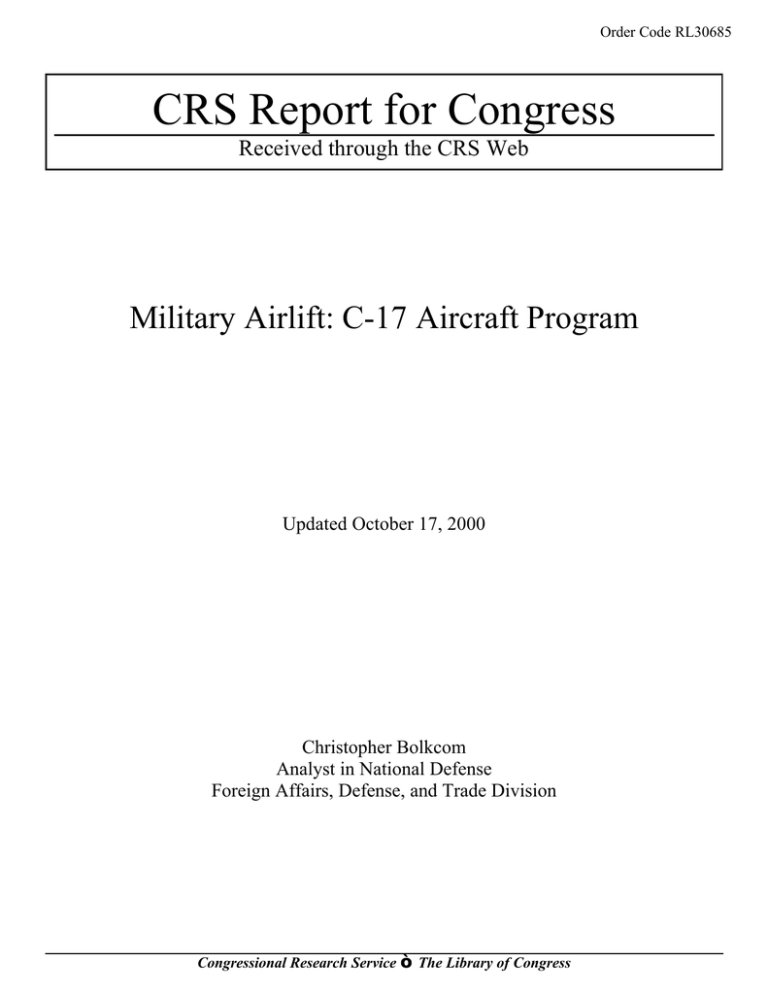
Order Code RL30685 CRS Report for Congress Received through the CRS Web Military Airlift: C-17 Aircraft Program Updated October 17, 2000 Christopher Bolkcom Analyst in National Defense Foreign Affairs, Defense, and Trade Division Congressional Research Service ˜ The Library of Congress Military Airlift: C-17 Aircraft Program Summary The C-17 Globemaster III is a long-range cargo/transport aircraft operated by the U.S. Air Force since 1993. Congress approved development of the aircraft in the late 1970s, when it was recognized that the Air Force did not have enough airlift capability. In 1981, the McDonnell Douglas C-17 emerged as winner of a competition with Boeing and Lockheed to develop a next-generation aircraft to replace C-130s and C-141s. Full-scale development of the C-17 got underway in 1986, but technical problems and funding shortfalls delayed the program, leading to slipped schedules and increased costs. Despite those difficulties, the C-17 has retained broad congressional support and enjoys strong Air Force and Army backing. Defense officials view the C-17 as essential in the post-Cold War environment, because of its ability to use smaller bases in remote areas. The C-17 first flew in 1991, about a year later than originally scheduled. Deliveries began in 1993, and in January 1995 the Air Force declared the aircraft fully operational. By January 2000, the Air Force had taken delivery of 57 C-17s, some of which were successfully used in Bosnia and later in Kosovo operations. Production problems in the late 1980s raised questions about the possibility of more cost-effective alternatives. In April 1990, Defense Secretary Cheney reduced the projected buy from 210 to 120 planes. In late 1993, DOD gave the contractor two years to solve production problems or face termination of the contract, with airlift shortfalls to be filled by modified commercial transport planes or existing military airlifters. By the mid-1990s, the program’s earlier difficulties had been largely resolved, although some questioned the number of C-17s to be procured. In 1996 DOD approved plans to order 80 more C-17s for a total of 120 aircraft — increased in late 1998 to 134. Through FY1999, some $28 billion was provided for the C-17 program, which would cost about $45 billion for development and procurement of 134 aircraft, as estimated in September 1999. For FY1997, Congress appropriated almost $2.2 billion for procurement of eight C-17s under a multiyear procurement contract. For FY1998, Congress provided $2.3 billion for the program, procuring nine aircraft. The FY1999 budget provided some $3 billion for procurement of 13 C-17s. The FY2000 budget provides about $3.1 billion for the program, procuring another 15 aircraft. For FY2001, the Administration requested some $3.1 billion for procurement of 12 C-17s. As of May 2000, the inventory of C-17s is 55 aircraft. Contents Introduction . . . . . . . . . . . . . . . . . . . . . . . . . . . . . . . . . . . . . . . . . . . . . . . . . . . 1 System Description . . . . . . . . . . . . . . . . . . . . . . . . . . . . . . . . . . . . . . . . . . . . . . 4 Performance Considerations . . . . . . . . . . . . . . . . . . . . . . . . . . . . . . . . . . . . . . . 4 Strategic Need . . . . . . . . . . . . . . . . . . . . . . . . . . . . . . . . . . . . . . . . . . . . . . . . . . 5 Production Problems . . . . . . . . . . . . . . . . . . . . . . . . . . . . . . . . . . . . . . . . . . . . . 7 Test Schedules . . . . . . . . . . . . . . . . . . . . . . . . . . . . . . . . . . . . . . . . . . . . . . . . . . 8 Some Alternatives . . . . . . . . . . . . . . . . . . . . . . . . . . . . . . . . . . . . . . . . . . . . . . . 8 Extend the Life of the C-141 . . . . . . . . . . . . . . . . . . . . . . . . . . . . . . . . . . . 8 Buy Fewer C-17s and More C-5s or Commercial Aircraft — The “NonDevelopmental Airlift Aircraft” (NDAA) Option . . . . . . . . . . . . . . . . 9 Cost Factors . . . . . . . . . . . . . . . . . . . . . . . . . . . . . . . . . . . . . . . . . . . . . . . . . . . 9 Congressional Action . . . . . . . . . . . . . . . . . . . . . . . . . . . . . . . . . . . . . . . . . . . . 10 Appendix 1: Bibliography . . . . . . . . . . . . . . . . . . . . . . . . . . . . . . . . . . . . . . . . 13 Appendix 2: Legislative History FY1996-FY1999 . . . . . . . . . . . . . . . . . . . . . . 14 List of Figures C-17 Globemaster III Taking off From Unfinished Runway . . . . . . . . . . . . . . . . 4 Military Airlift: C-17 Aircraft Program Introduction The Air Force’s C-17 Globemaster III is a long-range cargo/transport aircraft manufactured by Boeing (since its acquisition of McDonnell Douglas in 1997). Powered by four turbofan engines made by Pratt & Whitney, the C-17 is expected to meet U.S. strategic (long-range) airlift requirements, complementing the tactical (shorter-range) airlift capabilities of the C-130 cargo/transport planes built by Lockheed-Martin. The C-17 can carry some 169,000 lbs of outsize or oversized cargo (e.g., Abrams tanks and Apache helicopters) and can operate from small runways in remote areas where the larger C-5 heavy-lift cargo plane cannot be used. The program had a difficult time winning the support of Congress in the late 1970s, but funding was finally approved to begin development in FY1981. The program experienced delays and cost escalations throughout its development and early production period, and in late 1993 the C-17 program was threatened with cancellation after the delivery of 40 aircraft then under contract if production and cost problems were not resolved in two years. Thus, the Defense Department’s decision in November 1995 to buy the remaining 80 aircraft in a 120-plane program was a major event in the C-17 saga. In late 1998 the program was increased by 14 aircraft for the Special Operations Command, making it now a 134-plane program. The main hurdle in winning approval from Congress at the outset of the program was that the Air Force had not clearly demonstrated a need for additional strategic airlift capacity. The Soviet invasion of Afghanistan in December 1979 prompted President Carter to declare that the United States would defend its interests in the Persian Gulf by force if necessary. Concern that U.S. military forces might be ill-prepared to carry out such a mission led Congress to ask the Department of Defense (DOD) to conduct a study of the entire long-range strategic mobility situation, showing how much airlift and sealift would be needed to deploy forces to remote areas. Known as the Congressionally Mandated Mobility Study (CMMS), a classified report was sent to Congress in April 1981. The CMMS considered all modes of strategic mobility and what it would take to satisfy the simultaneous demands of a major war in Central Europe and any one of three lesser contingencies, including a deployment to the Persian Gulf. The study established several long-range strategic airlift goals that were considered attainable within the limits of realistic budget assumptions. One of the conclusions was that 66 million ton miles per day (MTMD) of airlift capacity would be needed by the year 2000. At the time of the study in 1981, the Air Force’s long-range cargo capability was only 29 MTMD. CRS-2 The Air Force submitted a request to build the McDonnell Douglas C-17 as the winner of a competition with several other firms, and Congress agreed to fund development of the plane. Just when the program was getting under way, however, DOD decided in early 1982 that the airlift shortfall was too urgent to await development of a new plane and that it would also be better to buy some planes already in production. Congress approved funds in the FY1983 budget to purchase 50 additional C-5 cargo planes (made by Lockheed) and 44 new KC-10 tanker aircraft (then made by McDonnell Douglas) to make up part of the airlift shortfall in the shortest time possible. Since the Air Force wanted to develop the C-17 as well as to buy additional C-5s, Congress directed the service to develop a comprehensive description of its future acquisition plans. The result was the Airlift Master Plan of September 1983, which compared several alternatives for modernizing the airlift fleet and concluded that the C-17 was the most cost-effective. The FY1985 budget included $129 million to begin full-scale development of the C-17 — then to be produced in a 210-aircraft program. The Airlift Master Plan had projected a requirement for 210 C-17s, with 180 in the active fleet and 30 additional aircraft for backup and spares and for testing and evaluation. The Air Force would also retain 114 C-5s but would turn many of these over to the Air Force Reserve and Air National Guard. By the mid-1980s the program appeared to be on track, if somewhat behind schedule. Production difficulties later delayed the program further, with slipped schedules and rising development costs. In April 1990, Defense Secretary Dick Cheney reduced the program from 210 to 120 production C-17s, reflecting revised estimates of airlift requirements in view of the collapse of the Soviet Union as well as budgetary restraints. In 1991-92, an updated Mobility Requirements Study (MRS) concluded that 57 million ton miles per day ( MTMD) would be required during the 1990s in a new set of scenarios based on changing international circumstances and reductions in the size and deployment of U.S. military forces. The study also concluded that even with 120 C-17 aircraft and commercial cargo and transport planes in the Civil Reserve Air Fleet (CRAF), the total U.S. cargo airlift capability would remain at 48 MTMD because of the phaseout of aircraft reaching the end of their service life. The April 1995 “Mobility Requirements Study Bottom-Up Review Update” (MRSBURU) concluded that 120 to 140 C-17s, or some comparable aircraft, would be needed in the 1990s. The Air Force agreed in December 1993 to buy another 12 C-17s during FY1994- FY1995, but Defense Secretary Les Aspin stated that the contract would end with the 40 aircraft then on order if McDonnell Douglas failed to resolve production and cost problems during that two-year period. In that event, DOD would buy a mix of C-17s and modified commercial transport planes or C-5 military transports to replace the aging C-141. By accepting the 1993 agreement, McDonnell Douglas incurred a loss of nearly $1.5 billion on the development phase of the program. In addition, the company agreed to spend $456 million in process improvements and testing. DOD agreed to provide an additional $438 million for the program — $237 million to settle claims with McDonnell Douglas and $201 million for flight testing. An October 1995 report by the Congressional Budget Office (CBO) stated: “If there was adequate room at airfields in regions of potential conflict, buying 32 more CRS-3 C-17s plus 30 C-33s [militarized version of Boeing 747s] would provide the same delivery capability as 80 additional C-17s. That option would also be nearly $8 billion cheaper.... If, however, U.S. forces were limited to a few airfields that had a small amount of ramp space, that option might not deliver cargo as quickly as would 80 more C-17s. And such a combination would not provide as much flexibility to handle specific military missions such as strategic brigade airdrops.... The appropriate mixture of planes depends on how much DOD and the Congress are willing to pay for the flexibility provided by 80 additional C-17s.” In November 1995, the Defense Department decided to continue procurement of the C-17 for a total program of 120 aircraft instead of meeting airlift requirements with a mix of C-17s, modified Lockheed C-5s, and Boeing 747s (designated as C-33s). The military services maintained that additional airlift capacity was critical and argued that if C-17s were not procured, other less capable cargo/transport aircraft would be needed to make up the shortfall. Most Members of Congress recognized the need for additional airlift, although some questioned the need to buy as many as 80 more C-17s. (See GAO/NSIAD-97-38 report cited in Bibliography.) In January 1996, the Defense Acquisition Board (DAB) approved plans to buy 80 C-17s over a seven-year period (FY1997-FY2003) in a multiyear contract that would be less expensive than either single-year buys or multiyear procurement over a longer period (with savings estimated at 5% of a projected program cost of $18 billion). The Air Force argued that buying the C-17 in six or seven years would provide the planes sooner and more cost-effectively and would avoid funding competition with other Air Force programs after 2003. Critics argued that such a long-term contract could entail financial penalties for reducing annual buys, if budgetary constraints in future years were to force the Air Force to choose between buying C-17s or other aircraft, such as F-22 fighter/attack planes. On May 31, 1996, the Air Force and McDonnell Douglas (now owned by Boeing) signed a $16.2-billion multi year procurement contract for 80 aircraft to be produced over seven years. The first of these 80 aircraft was delivered on August 10, 1998, bringing total deliveries to 41 aircraft. By January 2000, the Air Force had taken delivery of 57 C17s (40 funded annually and 17 funded under the multi year procurement contract). C-17s are currently based at Charleston AFB, SC (437th Airlift Wing) and McChord AFB, WA — each wing having an authorized force of 48 aircraft — and at Altus, OK (97th Air Mobility Wing), a training unit with eight C-17s. As projected in 1999, C-17s would also be operated by the Mississippi Air National Guard after 2004. In addition to the numbers of authorized operational aircraft, other C-17s would be in the maintenance/repair pipeline as well as being used for other operational missions, such as special operations. CRS-4 System Description1 Power Plant: Four Pratt & Whitney F117-PW-100 turbofan engines Wingspan: 169 feet 10 inches (to winglet tips) (51.76 meters) Length: 174 feet (53 meters) Height: 55 feet 1 inch (16.79 meters) Cargo Compartment: length, 88 feet (26.82 meters); width, 18 feet (5.48 meters); height, 12 feet 4 inches (3.76 meters) Speed: 450 knots at 28,000 feet (8,534 meters) (Mach .74) Service Ceiling: 45,000 feet at cruising speed (13,716 meters) Range: Global with in-flight refueling Crew: Three (two pilots and one loadmaster) Maximum Peacetime Takeoff Weight: 585,000 pounds (265,352 kilograms) Load: 102 troops/paratroops; 48 litter and 54 ambulatory patients and attendants; 170,900 pounds (77,519 kilograms) of cargo (18 pallet positions) Inventory: 55 C-17 Globemaster III Taking off From Unfinished Runway USAF photo by 1st Lt. Laurel Scherer Performance Considerations The Air Force maintains that the performance characteristics of the C-17 are significantly better than those of other cargo/transport aircraft. The C-17 can land on shorter runways and is more maneuverable on the ground than the larger C-5 or commercial transport planes, such as the Boeing 747, which would require much longer and wider runways. That factor limits the number of available bases and thus 1 Information derived from C-17 Globemaster III Fact Sheet, [http://www.af.mil/news/factsheets/C_17_Globemaster_III.html] and Air Force Magazine, 2000 USAF Almanac, May 2000. CRS-5 would complicate deployment planning for remote areas. In explaining the November 1995 decision to buy another 80 C-17s, DOD officials cited as a critical feature their calculations that eight C-17s could land and offload 3,852 tons per day in a space where only three modified 747s could operate, delivering 1,754 tons per day. The C-17 is also expected to be more cost-effective than its competitors based on projected life-cycle costs. The C-17's performance in the “reliability, maintainability, and availability evaluation” exercises of July-August 1995 confirmed its supporters’ expectations about operational capabilities with favorable cost implications, in part because fewer people are needed to operate and maintain the aircraft. (See Test Schedules below.) As part of the 1993 omnibus agreement between the Air Force and McDonnell Douglas, DOD agreed to change certain contract specifications that were causing design and cost problems. The most noteworthy of these changes included: cruise speed reduced from Mach 0.77 to Mach 0.74; maximum payload from 172,200 lb to 169,000 lb; and ferry range from 4,600 nmi to 4,300 nmi. Air Force General Ronald Fogleman, then head of the U.S. Mobility Command, said these changes did not affect critical operational requirements, explaining that a 3,200-mile mission with a 110,000-lb payload had been established as a goal and that the C-17 would meet or exceed this requirement. Strategic Need A critical question has been to what extent the C-17 may still be needed in the absence of Cold War threats to U.S. national security. Despite the disappearance of these threats, the Defense Department maintains its strong support for the C-17 as a long-range strategic airlift asset. The Air Force views the C-17 as the cornerstone of its airlift modernization program to replace older aircraft now nearing the end of their useful life. In the mid-1990s Air Force officials said that if the C-17 were canceled and work on a new plane started immediately, the first delivery would not be until 2005, when the C-141s then in service would be 35 to 40 years old. The Army’s strong support of this Air Force program was a critical factor in DOD’s decision in November 1995 to rely entirely on the C-17 to meet airlift requirements. The Army is largely dependent on the Air Force for rapid transportation of its forces in an emergency deployment. Army units deployed to Panama in 1989 were carried entirely by air, and after-action reports said that all U.S. airlift assets were fully employed during that period. DOD officials say the C-17 would have greatly facilitated the Panama operation (where the C-5 was difficult to use because it is hard to maneuver on the ground and ties up other traffic), adding that the C-17 would be even more necessary in operations where friendly airfields and troops on the ground might not be as available as they were in Panama. The massive military airlift to the Persian Gulf before and during the 1991 Gulf war further bolstered the case for the C-17. During the five months before the outbreak of hostilities, the Air Force moved more ammunition, weapons, food, and other military supplies than in any period in U.S. history, using almost all of its 283 CRS-6 C-5 and C-141 cargo planes at maximum utilization rates. The operation put heavy stress on older C-141s and probably shortened their remaining service life, making it impossible to maintain the 48 million ton miles per day (MTMD) level through the 1990s even with the C-17, according to the Air Force. The demands placed on available military cargo planes during the Persian Gulf buildup could not have been met without the call-up of the Civil Reserve Air Fleet (CRAF). About 110 commercial passenger and cargo aircraft were requisitioned when the program was activated for the first time in its 38-year history. Two-thirds of all passengers and one-fifth of all air cargo were moved to the Gulf by civil aircraft in the CRAF program. Commercial airlines in the program are compensated through the award of a share of the military airlift workload generated by the Air Force. As more troops are brought home and forward bases are given up, more airlift would be needed in an emergency, such as the Bosnian and Kosovo operations. In 1996, C-17s were successfully used in Operation Joint Endeavor missions in Bosnia: e.g., offloading cargos of some 165,000 lb in less than 15 minutes and carrying 44% of cargo delivered while performing 26% of airlift missions. According to contractor reports, the C-17 achieved a mission capable rate of 86.2 percent during the December 1995 through February 1996 time frame compared to a DoD-required rate of 81.2 percent.2 The C-17's ability to operate from austere airfields in Albania and Macedonia was further demonstrated during the Operation Allied Force in March-June 1999, when C-17s achieved a 96-percent mission-capable rate. In their joint testimony before the Senate Armed Services Committee, Secretary of Defense William Cohen and Chairman of the Joint Chiefs of Staff General Henry Shelton extolled the C-17's contributions to the Kosovo conflict. They said that “...the C-17 was the workhouse of the airlift force, providing for the rapid deployment of critical warfighting and humanitarian materiel.” Furthermore, they testified that “Throughout Operation Allied Force, U.S. forces had to overcome many limitations in transportation infrastructure. Poor airport surface conditions in Tirana, Albania, for example, slowed aircraft turnaround times, limited throughput, and slowed the onward movement of forces and humanitarian supplies. Our transportation and other logistic assets proved to be flexible, effective, and efficient in responding to these limitations. In particular, the C-17 made the concept of direct delivery – the strategic air movement of cargo from an aerial port of embarkation to an airfield as close as practicable to the final destination, a reality.”3 In early 2001 the Army announced its plan to transform itself into a lighter, more easily deployed fighting force. Army Chief of Staff Eric Shinseki announced his goal 2 U.S. General Accounting Office C-17 Globemaster — Support of Operation Joint Endeavor. GAO/NSIAD-97-50. February 1997. 3 U.S. Department of Defense. Joint Statement of William S. Cohen and General Henry H. Shelton. Senate Armed Services Committee Hearing on Kosovo After-Action Review. October 14, 1999: 11-12. CRS-7 was to create an Army that could deploy a brigade anywhere in the world in 96 hours, a division in 120 hours, and five divisions in 30 days. In response to Shinseki’s transformation plan, Air Force Chief of Staff Michael Ryan expressed doubt that it could be achieved, even if every single heavy lift asset were devoted to the task. Army Materiel Command Chief of Staff Maj. Gen. Charles Mahan thought the first two deployment goals (a brigade in 96 hours, and a division in 120 hours) was feasible, but the more sustained effort of moving five divisions in 30 days would also prove impossible. It appears that alternatives to current airlift fleet may merit exploration if all the Army’s deployment goals are to be achieved. Some British defense officials also view the C-17 as a strategic airlift asset that can be used in rapid-reaction operations. The United Kingdom’s Strategic Defence Review of July 1998 indicated that the Ministry of Defence might lease or buy several C-17s to meet air mobility requirements of Britain’s Rapid Reaction forces; however, funding for these aircraft had not been budgeted as of early 2000. In late 1998, the Air Force increased the 120-aircraft program by an additional 14 aircraft, which would be procured in FY2003-FY2005 for use by special operations forces, although procurement contracts for these additional aircraft had not been signed as of early 2000. In May 2000 it was reported that the U.K.’s Royal Air Force had committed to a $750 million deal to lease four C-17s from Boeing for seven years. A contract is expected to be completed by September 2000 with deliveries following in mid-2001. Britain has “conditionally committed” to purchase 25 Airbus A400M transports following the C-17 lease. Canada is another country that has given purchase of the C-17 some consideration. In May 2001 it was reported that the Canadian Department of National Defense had allocated almost $1 billion (U.S.) to meet strategic lift requirements. In addition to the C-17, Canada is considering the Airbus A400M and the Airtruck An7X. Lt. Gen. David Kinsman, chief of Canada’s Air Staff and commander of their Air Command said that Canadian forces have “a well established and recognized requirement for an outsized, C-17-like strategic airlifter.”4 Production Problems The C-17 was expected to be a low-risk development project, since most of its technology was to be “off-the-shelf.” McDonnell Douglas was sure enough of the design concept to enter into a contract based upon strong price guarantees and warranties of performance. Shortly after the first contract was awarded in 1981, however, the program was put on hold by DOD when it decided to buy an updated model of the C-5 and additional KC-10 tanker aircraft, a military version of the McDonnell Douglas DC-10 airliner. It took several years for the C-17 development program to regain momentum and by then, problems had developed on the production line and with subcontractors responsible for major components of the aircraft, such as the avionics, flight computers, and programs. 4 Scott, William. Bolder Budgets Restore Canada’s Air Force. Aviation Week and Space Technology. June 26, 2000. CRS-8 The result was that fabrication and assembly of the first development aircraft was delayed from December 1987 to August 1988, causing postponement of the aircraft’s first flight from February 1990 to September 1991. During that period, congressional funding committees began questioning the contractor’s ability to deliver on schedule, making incremental cuts in the C-17 budget, and linking future funding to production performance. These restrictions became more stringent each year as other production and management problems arose. Since 1995 the aircraft have been delivered to the Air Force on or ahead of schedule. Test Schedules System-level testing began on the C-17 in late 1992. Early testing was conducted by the contractor and Air Force members of the Combined Development Test and Evaluation/Initial Operational Test and Evaluation test team. Initial engineering tests developed the aircraft and its systems, compared the performance to contract specifications, and prepared for later operational testing. Comprehensive mission testing by operational personnel using operational bases and procedures occurred in late 1994 through early 1995. Some 300 hours of flight testing were performed at Edwards AFB, California, and operational deployment sites, using a production-representative test plane. Initial squadron operations at Charleston AFB, South Carolina, included a 30-day Reliability, Maintainability, and Availability Evaluation (RM&AE) in July-August 1995. The C-17s participating in these RM&AE exercises demonstrated notable operational success, with overall reliability of 99% and 98% of missions completed successfully. Some Alternatives Opponents of the C-17 have proposed alternatives ranging from extending the service life of cargo planes now in service to relying more on sea lift. Timeliness is the strongest argument for delivering military cargo by air, and some analysts believe that where time is not so critical it would be possible to use sea lift instead of buying additional airlift assets. The Department of Defense has steadfastly defended the C-17, arguing that it will be needed even more, as more U.S. troops return from overseas stations. The Air Force continues to assert that the C-17 holds high priority in relation to other Air Force programs, pointing out that the current U.S. airlift capability is only about 48 million ton miles per day compared to the 57 MTMD stipulated in the 1992 Mobility Requirements Study. Extend the Life of the C-141 Some have suggested that the C-141 be kept in service longer by means of a Service Life Extension Program (SLEP). Under this concept, parts of the plane that are worn out or dangerous would be replaced in order to keep the C-141s in service until an affordable replacement is found. The Air Force maintains, however, that the C-141 is already well beyond its original service life and is limited in the kinds of CRS-9 missions it can perform. Earlier modifications increased the life of the planes from about 25,000 hours to 45,000 hours, but even if their service lives were extended, C-141s could not carry outsized cargo such as tanks, helicopters, and large vehicles and artillery. These items are more easily and economically transported by ship, but in an emergency when time is critical, only the C-5 or the C-17 can carry military equipment that large and bulky. Buy Fewer C-17s and More C-5s or Commercial Aircraft — The “Non- Developmental Airlift Aircraft” (NDAA) Option Another proposed alternative was to buy fewer C-17s and to make up the shortfall with additional C-5s and commercial transport/cargo aircraft — referred to as “non-developmental airlift aircraft” (NDAAs). The leading candidate in the NDAA option was a military version of the Boeing 747 jumbo jet, designated as the C-33. These Boeing C-33s would not be replacements for the C-17 but would fill the need for routine cargo flights between large airports. The C-17 can be operated on unimproved surfaces and can unload under austere conditions. Proponents of the NDAA argued that its acquisition cost would be less than that of the C-17, whose special performance features would not be needed in many airlift operations. Air Force officials conceded that in some situations a mix of C-17s and NDAAs might be the most cost-effective way to carry military cargo. However, DOD’s decision in November 1995 reflected a choice of an all-C-17 force of 120 aircraft (including the 40 then under contract) in lieu of a C-17/NDDA mix. A report by the Congressional Budget Office in early 1997 considered the costs and capabilities of five alternatives to current Administration plans for modernizing strategic airlift and sea lift, including buying fewer C-17s with estimated savings of $8.4 to $18.9 billion in 1998-2020. ( U.S. Congressional Budget Office. Moving U.S. Forces: Options For Strategic Mobility. [by] Rachel Schmidt. CBO Report, February 1997; U.S. General Accounting Office. Military Airlift — Options Exist for Meeting Requirements While Acquiring Fewer C-17s. GAO/NSIAD-97-38, February 1997.) Cost Factors A major issue in the C-17 program has been the lower acquisition costs of the proposed NDAA alternatives as projected by their manufacturers. As of September 30, 1999, DOD estimated a 134-aircraft program to cost $44.9 billion, of which some $28 billion was spent in developing and procuring the aircraft through FY1999. Unit costs have been reduced by multiyear procurement. Under the multiyear production contract of May 31, 1996, 80 aircraft are to be produced during the 1996-2003 period for some $16.2 billion, at a program unit cost of $202.5 million. (Bender, Bryan, and Sheila Foote. Pentagon Signs $16 Billion Deal for C-17 Transport Planes. Defense Daily, June 3, 1996: 366-367.) CRS-10 Congressional Action The Administration’s FY2001 defense budget, submitted on February 7, 2000, requested $3,067.3 million for the C-17 program: $2,890.9 million for procurement of 12 aircraft and $176.4 million in research-development (R&D) funds. DOD officials stated that buying 12 aircraft in FY2001 instead of 15 as originally planned would not break the multi year contract for 80 C-17s to be procured over seven years (FY1997-FY2003). DoD expressed confidence that the United Kingdom would strongly consider buying two or three C-17s, which would help keep the Globemaster production line warm. Also, Canada was viewed as a potential customer to help make up the three aircraft gap. Initial FY2001 authorization and appropriation activity in Congress has been supportive of the C-17 Program. All of the defense oversight committees recommended the 12 aircraft purchase. In H.Rept. 106-616, H.R. 4205, the House Armed Services Committee recommended authorization of $25.9 million in excess of the administration’s procurement request for an additional weapon system trainer and a maintenance training system. In their report 106-292, S. 2549, the Senate Armed Services Committee increased the administration’s $97.1 request for C-17 modifications by $26.4 million to procure an additional C-17 cockpit system simulator and to complete procurement of the C-17 maintenance systems trainer. Both House and Senate authorizors matched the administration’s request for C-17 R&D funds. In H.Rept. 106-644, H.R. 4576, the House Appropriations Committee supported the Administration’s plan to procure 12 C-17s. However, based on the Air Force’s own analysis, the committee determined a reduced need for procurement and recommended appropriations $26.1 million less than requested. The committee supported the administration’s request for C-17 R&D funds. Senate appropriators took a different approach than the other oversight committees on C-17 funding. In S.Rept. 106-298, S. 2593, the Senate Appropriations Committee wrote that “The Committee has fully funded the budget request amount for C-17 aircraft procurement, C-17 advanced procurement, and C-17 interim contractor support. However, the Committee recommendation transfers the C-17 program to the ‘National Defense Airlift Fund’ account and appropriates all requested funds within this account.”5 Defense Subcommittee Chairman Sen. Ted Stevens told reporters in May 2000 that the airlift fund is modeled after the National Defense Sealift fund that was created several years ago. “We think airlift is a number one priority for the country...” Stevens was quoted as saying.6 The intent of the new fund is to recognize that the C-17 is an asset that benefits all the services and to protect this 5 106th Congress. U.S. Senate. Report 106-298, S. 2593. Department of Defense Appropriation Bill, 2001. May 18, 2000. 6 Duffy, Thomas. Senate Appropriators Create Airlift Fund to Protect C-17 Money. Inside the Pentagon. May 18, 2000. CRS-11 money from competition within the Air Force for its service-specific resources. The committee supported the Administration’s request for C-17 R&D funds. The appropriations conference (H.Rept. 106-754, H.R. 4567) adopted the National Defense Airlift Fund concept. Appropriators recommended $2,428,723,000 for the procurement of 12 C– 17 aircraft and advance procurement for the fiscal year 2002 purchase of 15 DC–17 aircraft. $412,200,000 was included for the interim contractor support of the existing C–17 fleet. The conferees directed that the C–17 procurement and fleet support programs continue without any interruption during FY2001. Appropriators also supported the administration’s request for C-17 R&D funds. Authorization conferees supported the Administration’s request to purchase 12 C-17s, with modifications to FY2001 and advance year procurement. Conferees reduced FY2001 funding by $41 million, and decreased advance procurement by $9 million “due to a revision of advance procurement funding requirements.” (H.R. 4204, p. 617). The FY2000 defense budget requested $3,555.7 million for the C-17 program: $3,385 million in procurement funds for 15 aircraft and $170.7 million in R&D funds. The Senate version of the FY2000 defense authorization bill (S. 1059), passed on May 27, 1999, authorized funding for the program as requested; the House version (H.R. 1401), passed on June 10, 1999, also authorized the funding requested as well as an additional $3.5 million in procurement funds for the C-17. House and Senate conferees (H.Rept. 106-301/P.L. 106-65) agreed to authorize C-17 funding as requested. The Senate version of the FY2000 defense appropriations bill (S. 1122) funded the program as requested and authorized by the Senate. The Senate Appropriations Committee also recommended “new multiyear procurement authority to allow the Air Force to enter into negotiations on the procurement of sixty additional C-17s” (S.Rept. 106-53); this second multiyear procurement would begin in 2003 at the end of the current 7-year contract. The House version (H.R. 2561), provided $412.3 million less than the $3,385 million requested and authorized for procurement. The conference report on FY2000 defense appropriations ( H.Rept. 106-371/P.L. 106-79) provided $3,135.2 million for the C-17 program ($2,974.3 million in procurement and advance procurement funds; $160.9 million in R&D funds). Sections 8008 and 8145 of the conference report granted authority for a follow-on multi year contract for 60 more C-17s if the Secretary of the Air Force certifies that the average unit flyaway price of these aircraft will be “at least twenty-five percent below the average unit flyaway price” of the 80 aircraft currently in multi year procurement “with both prices calculated in fiscal year 1999 dollars.” CRS-12 Appendix 1: Bibliography Butler, Amy, and Adam J Hebert. DOD Explanation for Delayed C-17 Buy at Odds with Boeing Assertions. Inside the Air Force, February 11, 2000: 1, 24-25. Bender, Bryan, and Sheila Foote. Pentagon Signs $16 Billion Deal for C-17 Transport Planes. Defense Daily, June 3, 1996: 366-367. Defense Acquisition Board Endorses Multi-Year Buy Option for 80 C-17s. Inside the Pentagon, January 18, 1996: 1-2. Foote, Sheila. Appropriators Back C-17 Multi year Buy, with Conditions. Defense Daily, April 1, 1996: 2-3. Fruehling, Gudrun R., and David Silverberg. The C-17: From Trouble to Triumph. Armed Forces Journal International, September 1995: 35. Mulholland, David. DoD Officials Likely Will Place Future C-17 Orders. Defense News, March 20, 2000: 8, 36. Offley, Ed. C-17's Role in Kosovo May Lead To Pentagon’s Purchase of More. Seattle Post-Intelligencer, June 4, 1999: B2. Roos, John G. Getting a Needed Lift. Armed Forces Journal International, July 1996: 40-41. U.S. Congressional Budget Office. Moving U.S. Forces: Options For Strategic Mobility. [by] Rachel Schmidt. CBO Report, February 1997: 117 p. U.S. General Accounting Office. Military Airlift — Options Exist for Meeting Requirements While Acquiring Fewer C-17s. GAO/NSIAD-97-38. February 1997: 62 p. —— C-17 Globemaster — Support of Operation Joint Endeavor. GAO/NSIAD-97-50. GAO/NSIAD-97-50. February 1997: 12 p. CRS-13 Appendix 2: Legislative History FY1996-FY1999 The FY1999 budget requested $3,023.6 million for the C-17 program: procurement, $2,900.5 million; R&D, $123.1 million. Procurement funding in FY1999 bought 13 aircraft in a multiyear buy of 80 aircraft over a seven-year period (FY1997-FY2003). The House and the Senate authorized FY1999 funding for the C-17 as requested (H.Rept. 105-532 on H.R. 3616, S.Rept. 105-189 on S. 2057). The House appropriated C-17 funding as requested in H.R. 4103, the Senate version of the FY1999 defense appropriations bill (S. 2132) contained procurement funds as requested but reduced R&D funding to $108.1 million of the $123.1 million requested. House and Senate conferees agreed in H.Rept. 105-746, to appropriate procurement funds as requested and $119.1 million of the $123.1 million requested for R&D. FY1999 defense authorizations and appropriations bills were enacted on October 17, 1998, as P.L. 105-261 and P.L. 105-262, respectively. Also included in the FY1999 defense budget was a request for $125.8 million to procure a C-130J aircraft, the latest version in the C-130 Hercules series of cargo/transport planes produced by Lockheed since the 1950s. The C-130J upgrade “will address the need to modernize U.S. tactical airlift capability,” according to DOD budget documents. The C-17 is expected to modernize long-range strategic airlift capability, while the C-130J would be used in theater operations at shorter range. Congress authorized and funded procurement of seven C-130 aircraft in FY1999 — 3 C-130Js for the Air National Guard; 2 KC-130J tanker aircraft for the Marines; and 1 EC-130J and 1 WC-130J for the Air Force. For FY1998, the Administration requested $2,315.1 million for the C-17 program in procurement ($2,201.5) and R&D ($113.6) funding for nine aircraft in a multi year buy of 80 aircraft through FY2003. In addition, some $9.7 million was requested in military construction funds, mainly related to enlarging hangars. Both the House National Security Committee and the Senate Armed Services Committee recommended authorization of C-17 funding as requested for FY1998, which was authorized by the House (H.R. 1119) and by the Senate (S.936). The House appropriated $2,179.8 million in procurement funding for nine C-17s in FY1998. The Senate version of the FY1998 defense appropriation bill (S. 1005) provided $2,641.5 million for procurement of 11 C-17s. The FY1998 defense appropriation bill (H.R. 2266/P.L. 105-56) provided $2,290.4 million of the $2,315.1 million requested for a 9-aircraft buy. Funding for the program in FY1997 totaled $2,269.7 million — $2,117.0 million in procurement funding for eight planes, $71.8 million in R&D funds, and $80.9 million for military construction related to the C-17. (Smaller amounts of military construction funding for the C-17 have also been included in other annual budget requests and congressional appropriations.) The Administration’s FY1997 budget was expected to fund procurement of the first eight planes in a multi year buy of 80 aircraft over a seven-year period (FY1997-FY2003). Congressional approval of such a multiyear procurement was included in the Senate version of an omnibus budget bill (S. 1594, Section 803, Congressional Record, March 19, 1996: S2284), but this language was not in the House version of CRS-14 the bill (H.R. 3019), passed earlier (Congressional Record, March 7, 1996: H1808). During Senate debate on S. 1594, Senator Warner noted that the Senate Armed Services Committee had expressed to the Air Force its strong opposition to proceeding with such a long-term commitment of defense procurement funds without allowing the committee an opportunity to review the matter. (Congressional Record, March 14, 1996: S2070- S2071.) On March 28, 1996, the Committee held a hearing on C-17 multi-year procurement issues (MDC’s Kozlowski Defends MYP C-17 Saving, Cites Small Buy. Aerospace Daily, March 29, 1996: 492 and Eurich, Heather J. GAO Halves Estimate on C-17 Multi year Proposal Savings. Defense Daily, March 29, 1996: 483.) House and Senate conferees on H.R. 3019 agreed to a C-17 multi year procurement that would provide savings of more than the 5% projected earlier. (Foote, Sheila. Appropriators Back C-17 Multi year Buy, with Conditions. Defense Daily, April 1, 1996: 2-3.) H.R. 3019 was enacted on April 26, 1996, as P.L. 104-134, thus resolving the FY1997 budget issue between Congress and the Administration. The House versions of the FY1997 defense authorizations bill (H.R. 3230) and defense appropriations bill (H.R. 3610) approved a buy of 10 C-17s in a six-year procurement contract. The Senate version of the FY1997 defense authorizations bill (S. 1745) authorized procurement of nine C-17s, with the details of a multi year procurement contract regarding termination costs and alternative annual procurement costs to be determined later (S.Rept. 104-267: 89). The Senate version of the FY1997 defense appropriations bill (S. 1894) provided funding for eight C-17s as requested (S.Rept. 104-286: 81, 126). House and Senate conferees agreed to authorize $87.5 million as requested for R&D and $2,376.8 million in procurement funds for nine or more C-17s in FY1997 as part of a multi year procurement program. On August 1, 1996, the House passed the conference report on FY1997 defense authorizations (H.Rept. 104-724). On September 30, 1996, the President signed an omnibus FY1997 appropriations bill (H.R. 3610/ P.L. 104-208), which provided $2,202 million in Air Force procurement and development funding in FY1997 for multiyear procurement of eight C-17s — somewhat less than the Administration’s request of $2,230 million for the program. For FY1996, the Administration requested $2,612.7 million for the C-17 program (including $117.5 million for initial spares, $85.8 million for R&D, and $6.9 million for military construction), funding procurement of eight aircraft. The House version of the FY1996 defense authorizations bill (H.R. 1530) authorized funding for the C-17 program as requested by the Administration and recommended by the House National Security Committee. H.R. 1530 also authorized $254 million that might be used as advance funding for procurement of commercial transport planes in lieu of additional C-17s, if the Defense Department chose what was termed the “non-developmental airlift aircraft” (NDAA) option; otherwise, this amount could be used as C-17 funding. The committee noted “that consideration of an NDAA option was initiated originally out of concern that the C-17 program was not performing well. However, the committee observes that there have been positive achievements of the C- 17 program within the past year. Recent deliveries of C-17s have been ahead of schedule, and both the quality and production performance have improved significantly.” CRS-15 The Senate version of the FY1996 defense authorizations bill (S. 1026) also authorized funds for the C-17 program as requested, with a reduction of $21.9 million in procurement funding for spare parts in concurrence with current Air Force plans. S. 1026 also authorized the $183.8 million requested for “strategic aircraft,” for which the House bill authorized $254 million to buy either commercial transport planes or additional C-17s as noted above in regard to H.R. 1530. The House version of the FY1996 defense appropriations bill (H.R. 2126) provided the $2,488 million requested for an 8-aircraft buy; the Senate version (S. 1087) provided $2,635 million. House and Senate conferees agreed to $2,486 million in a conference report that the House rejected on September 29, 1995, for reasons not related to the C-17 program. On November 16, 1995, a modified conference report, which funded the C-17 program as provided in the earlier conference report ($2,486 million in FY1996 procurement and R&D funds), was passed by the House and Senate and was enacted without the President’s signature on December 1, 1995, as P.L. 104-61. FY1996 funding for the C-17 was authorized in P.L. 104-106 (passed by Congress and signed by the President on February 10, 1996), which authorized funds for combat aircraft as appropriated earlier in P.L. 104-61.
